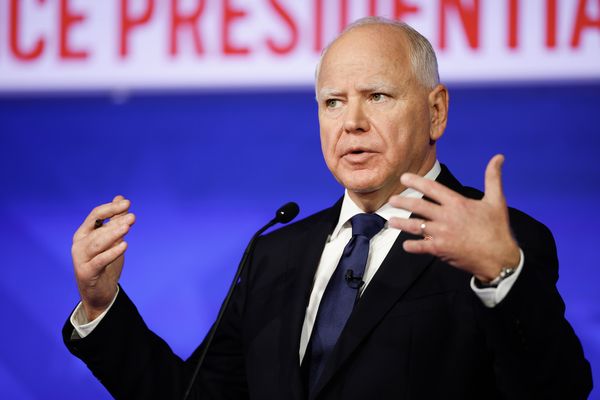
What’s the deal with ultra-long hair? Why is there suddenly so much of it about – and why is it being smugly swished about in our faces like coiffured, over-fragranced horse tails?
I don’t mean young women and girls, for whom long hair occurs almost as a byproduct of youth, and who wear it as insouciantly as a daisy-chain necklace. Nor is this longish hair (gliding down the neck or tickling between the shoulder blades).
I’m referring to that faux-casual, triumphantly cascading ultra-long hair (ULH) that’s been called under-the-boob hair. It’s also termed “princess hair”, alongside editorials inviting us mere commoners to gasp over “the Princess of Wales’s memorable hair moments”. (When surely the whole point of royal hair is that it isn’t memorable – in the sense of being confrontational or objectionable – in any way?) Elsewhere, it’s sported by a certain kind of powerful, moneyed, older woman. Gwyneth Paltrow. Demi Moore. Amal Clooney. This, you realise, is hair as a mid-life power move. Hair with inbuilt messaging. Hair that makes the follicular political.
Still, “princess hair” – seriously? Even taken as part of the process of the ongoing infantilisation of the 21st-century woman, this seems top-tier creepy and reductive. When do you ever see men hectored into princeing up their hair? Nor is this piece going to be about men preferring the look of longer-haired ladies (it’s a rare and needy modern woman who gives more than 20 seconds of thought to what straight men think of her hair). Still, these power manes are intriguing. Are they about female rebellion (which we could all get behind), or uber-conformity? Or is it just another grooming stick with which to beat beleaguered, exhausted, middle-aged women?
There’s a good reason why it’s mainly wealthy celebrities preening about with glossy, voluminous, ultra-long hair. As much as this kind of hair is yet another style that’s exclusionary against black women (though on the “iconic 1980s-supermodels” cover of September’s Vogue, Naomi Campbell aces the look in a beautiful wig), it manages to exclude vast numbers of white women too.
This kind of style might look “free and easy” but achieving it would be anything but, especially with older hair. Even if hair doesn’t thin, it ages with the rest of you. Even if you sort out the colour and don’t (always) end up resembling Catweazle or mid-period Alice Cooper, there is still the small matter of (whisper it) texture. Which, if you’re not vigilant, does a simultaneous “limp/crunchy” thing that doesn’t even seem scientifically possible.
Thus, one presumes, any attempt to turn the hair on an average middle-aged head into a power mane would require a squad of highly skilled professionals trained in the dark arts of ninja-level tonging/blow-drying, lakes of conditioner, keratin treatments, warehouses of “product”, extensions and so on. Your life would turn into a relentless nightmarish prep for a photoshoot that (unlike the Vogue “supers” or other celebrities) never actually transpires. And that’s not counting the discreet “rejuvenating procedures” to make the face “match” the hair. In your ULH-desperation, you might even find yourself agreeing to the dreaded head massage during the salon hair wash. What have you become?
So, “free and easy” be damned. ULH would require the staffing levels of a busy boutique hotel, and the wage bill to match. An ordinary woman would have to groom herself into oblivion or bankruptcy (whichever came first). Or she could go rogue, attempt a budget DIY version, and risk ending up resembling the cackling Disney crone who gives the apple to Snow White. Which, incidentally, I consider to be a strong look (what could be prettier than a woman embracing her inner witch?), but, sadly, that’s not the vibe being chased here.
Ultimately, ultra-long hair is a tale as old as time. Leastways, it’s a game of two signifiers. The first being youth. Some people think chopping off your hair is ageing, and that’s that. And, as much as the truly young try to go with trends that defy emulation (all that midriff-baring is no accident), this is an era in which older generations point-blank refuse to age, to cede youth to the young. They wear their clothes, listen to their music, go to their festivals. Now – quelle surprise! – they’re going after their hair.
Moreover, as detailed above, ultra-long hair is a wealth signifier, and therefore one of elitism. This is the kind of hair not all ordinary women could afford to access or maintain. It’s a key way of distinguishing yourself from the masses. If the word is out about weight-loss drugs such as Ozempic, and excessive skinniness doesn’t cut it any more, then how about some difficult, expensive, elitist hair? For now, there’s no sorting that out with a pill.
All women are entitled to the hair they want, but it turns out the secret of ultra-long hair isn’t much of a secret at all. Rather boringly, it seems to be less about extremism/rebellion/self-expression, and more about elitism. And less about starting a trend and more about keeping all the swishy pampered gorgeousness to yourself. In case you hadn’t already noticed, the rich always find a way.
• Barbara Ellen is an Observer columnist
Do you have an opinion on the issues raised in this article? If you would like to submit a letter of up to 250 words to be considered for publication, email it to us at observer.letters@observer.co.uk







